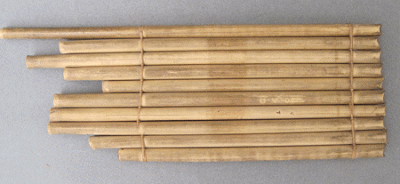 |
| 1886.1.1560 Panpipes |
Several sets of panpipes (mimiha) from Tonga were brought back by the Forsters from the second voyage. This set, and one now thought to be from Vanuatu were listed in the 'Catalogue of Curiosities' as 'No. 84 and 85 Two of Pan's pipes or syringae'
There are ten bamboo pipes in the set, bound together with plant fibre. The bottom of each pipe is closed by a natural node in the bamboo, and the top edge has been bevelled to make it easier to blow into.
 |
| Detail to show bevelled top edges of pipes |
It has been suggested that panpipes in Tonga were used by the lower classes as a substitute for the noseflute, which was a chiefly instrument. The panpipes could suggest the sound of two noseflutes playing together, and the number of pipes and their tuning could have been suggested by the tuning of the noseflute. Unlike the modern South American panpipe, the tune was almost 'built in' to the design of the Tongan pipes, and the player just had to move the instrument across his lips.
The plant fibre binding on the pipes has broken in several places, and is very brittle. In a previous conservation treatment, possibly in 1970 before conservation records at the Pitt Rivers began, very fine nylon fishing line has been used just above each line of plant fibre to tie the pipes together and stabilise them. The fishing line is virtually invisible and is not damaging the pipes, and so it will not be removed.
See Adrienne Kaeppler, 'A study of Tongan Panpipes' Ethnos 39 (1-4) 1974 pp102-128